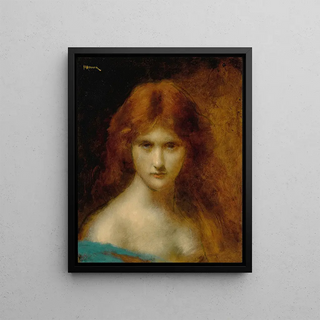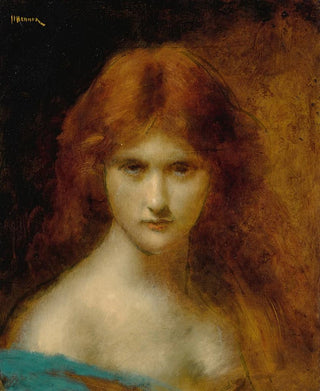Art print | Judith - Jean-Jacques Henner


View from behind

Frame (optional)
The "Judith" canvas by Jean-Jacques Henner, created in 1888, immerses us in a universe where beauty and tragedy intertwine. This iconic artwork evokes the biblical legend of Judith, a strong and determined woman who saves her people by beheading the Assyrian general Holopherne. Henner, with his mastery of light and shadow, manages to capture the very essence of this complex character. The depiction of Judith, both alluring and resolute, invites us to reflect on the duality of human nature. This canvas, both powerful and delicate, embodies a unique aesthetic that transcends eras.
Style and uniqueness of the work
Jean-Jacques Henner's style is distinguished by his ability to blend realism and symbolism. In "Judith," the warm color palette and subtle flesh tones reveal a particular sensitivity to light. The drapery of Judith's dress, beautifully rendered, almost seems alive, adding a tactile dimension to the work. Henner strives to unveil not only the physical beauty of his subject but also her soul, thoughts, and emotions. Judith's posture, with her gaze both determined and melancholic, directly engages us, as if she were confiding her secret. This interplay between strength and fragility is one of Henner's characteristic traits, who succeeds in creating an atmosphere of intimacy while evoking universal themes.
The artist and his influence
Jean-Jacques Henner, born in 1829 in Altkirch, Alsace, is a significant figure of the 19th-century French painting movement. Trained at the École des Beaux-Arts in Paris, he established himself thanks to a personal style that diverges from the academic conventions of his time. Henner was influenced by Renaissance masters, but also by the Romantic movement, which is reflected in his works through a particular focus on emotions and the psychology of characters. His innovative use of light and color has inspired many contemporary and later artists. By redefining the standards of

Matte finish

View from behind

Frame (optional)
The "Judith" canvas by Jean-Jacques Henner, created in 1888, immerses us in a universe where beauty and tragedy intertwine. This iconic artwork evokes the biblical legend of Judith, a strong and determined woman who saves her people by beheading the Assyrian general Holopherne. Henner, with his mastery of light and shadow, manages to capture the very essence of this complex character. The depiction of Judith, both alluring and resolute, invites us to reflect on the duality of human nature. This canvas, both powerful and delicate, embodies a unique aesthetic that transcends eras.
Style and uniqueness of the work
Jean-Jacques Henner's style is distinguished by his ability to blend realism and symbolism. In "Judith," the warm color palette and subtle flesh tones reveal a particular sensitivity to light. The drapery of Judith's dress, beautifully rendered, almost seems alive, adding a tactile dimension to the work. Henner strives to unveil not only the physical beauty of his subject but also her soul, thoughts, and emotions. Judith's posture, with her gaze both determined and melancholic, directly engages us, as if she were confiding her secret. This interplay between strength and fragility is one of Henner's characteristic traits, who succeeds in creating an atmosphere of intimacy while evoking universal themes.
The artist and his influence
Jean-Jacques Henner, born in 1829 in Altkirch, Alsace, is a significant figure of the 19th-century French painting movement. Trained at the École des Beaux-Arts in Paris, he established himself thanks to a personal style that diverges from the academic conventions of his time. Henner was influenced by Renaissance masters, but also by the Romantic movement, which is reflected in his works through a particular focus on emotions and the psychology of characters. His innovative use of light and color has inspired many contemporary and later artists. By redefining the standards of






